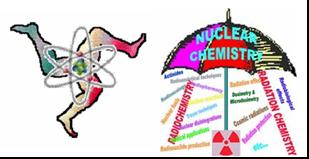Speaker
Dr
Stella Antoniou
(University of Cyprus)
Description
The paper presents and discusses data obtained from investigations regarding the effect of natural organic matter (e.g. humic acid) on the formation and solubility of secondary solid phases of polyvalent metal ions (e.g. M(VI), M(IV), M(III)) in aqueous solutions of 0.1 M NaClO4 and under normal atmospheric conditions. The investigations were performed using hexavalent uranium as analogue for M(VI), tetravalent thorium, cerium and zirconium as analogues for M(IV) and trivalent samarium and neodymium as analogues for M(III). The solid phases under investigation have been prepared by alkaline precipitation in the presence and absence of humic acid and characterized by TGA, ATR-FTIR, XRD and solubility measurements. The experimental data obtained indicate generally that the solids phases, which are formed in the absence of humic acid, are stable and remain the solubility limiting solid phases even in the presence of increased humic acid concentration (up to 0.5 g/l) in solution. Although polyvalent metal ions form very stable complex with humic acid, upon base addition in the M(z)-humic acid system decomplexation of the previously formed M(z)-humate complexes and precipitation of two distinct phases occurs, namely, the inorganic and the organic phase. The latter is adsorbed on the particle surface of the former. However, natural organic matter (humic acid) affects the particle size of the solid phases and may lead to reduction of redox-sensitive species. Generally, increasing humic acid concentration results in decreasing crystallite size of the inorganic solid phase. The extent of the effect depends inversely on the solid phase stability. The impact on the solid phase properties even for the less stable solid phases is expected to be of minor relevance regarding the chemical behavior and migration of polyvalent metal ions in the geosphere.
Keywords: polyvalent metal ions, humic acid, solid phase formation, solubility
Author
Dr
Stella Antoniou
(University of Cyprus)
Co-author
Prof.
Ioannis Pashalidis
(University of Cyprus)
